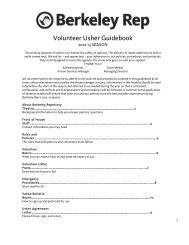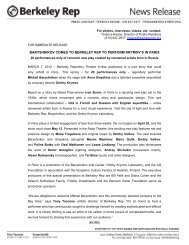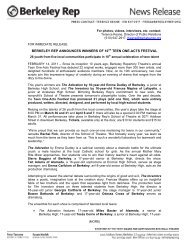the berkeley rep magazine - Berkeley Repertory Theatre
the berkeley rep magazine - Berkeley Repertory Theatre
the berkeley rep magazine - Berkeley Repertory Theatre
Create successful ePaper yourself
Turn your PDF publications into a flip-book with our unique Google optimized e-Paper software.
information, because a text cannot provide <strong>the</strong> context or flexibility<br />
that a conversation with ano<strong>the</strong>r person can.<br />
To <strong>the</strong> literate 21st-century mind, this stance is boggling.<br />
Just imagine for a moment a world in which we had to constantly<br />
hold in our minds everything we wanted to remember.<br />
Imagine if all of <strong>the</strong> information that we had ever acquired<br />
or ever shared with ano<strong>the</strong>r person through writing—from<br />
newspapers, books, and blogs to letters and emails—had<br />
instead been transmitted out loud and face to face. It would be<br />
impossible for us to live with <strong>the</strong> global sensibilities that we do<br />
now without being able to write things down.<br />
But <strong>the</strong> world was much smaller in <strong>the</strong> fourth century BC,<br />
in <strong>the</strong> days of <strong>the</strong> great orators who could recite entire epic<br />
poems and plays from memory (The Iliad is 15,693 lines long)<br />
or deliver stirring and complex speeches without any notes.<br />
Though early speakers may not have had <strong>the</strong> luxury of index<br />
cards or Teleprompters, <strong>the</strong>y did have <strong>the</strong> incredible powers of<br />
a mind trained in <strong>the</strong> art of memory.<br />
In her excellent book, The Art of Memory, Frances Yates<br />
explores mnemonic devices throughout history. She begins<br />
with <strong>the</strong> Greeks, and <strong>the</strong> famously prodigious capacity of <strong>the</strong><br />
orators to remember large amounts of information. Only a<br />
few texts on <strong>the</strong> art of memorization survive from <strong>the</strong> Greco-<br />
Roman period. Our understanding of <strong>the</strong>se works, like so<br />
many records from this time, is incomplete, but Yates has<br />
never<strong>the</strong>less been able to draw some fascinating conclusions.<br />
The Greeks distinguished between two kinds of memory:<br />
natural—what our minds just happen to remember, like scenes<br />
from childhood or a delicious meal—and artificial—<strong>the</strong> memory<br />
that we seek to cultivate. When you deliberately memorize a<br />
poem or your bank account number, it is <strong>the</strong> artificial memory<br />
that gets exercised.<br />
There were many different approaches to mastering this<br />
system, but perhaps <strong>the</strong> most interesting are <strong>the</strong> memory<br />
palaces. According to legend, this practice first began with <strong>the</strong><br />
poet Simonides. While he was attending a banquet, <strong>the</strong> roof<br />
collapsed and crushed everyone else in <strong>the</strong> room. Even though<br />
<strong>the</strong>ir bodies were unrecognizable, Simonides was still able<br />
to identify each guest based upon where <strong>the</strong>y were sitting.<br />
Memory palaces function in a similar way—using location and<br />
spatial reasoning to remember facts and ideas. In your mind’s<br />
eye, you are to picture a familiar architectural space in great<br />
detail, even paying attention to lighting and temperature (one<br />
text recommends empty civic buildings, but your house would<br />
do too). In each room, you place an object that symbolizes<br />
something you want to remember. For example, you might<br />
signify Hektor, <strong>the</strong> Trojan prince and “tamer of horses,” using<br />
his horsehair plume helmet. As you walk through <strong>the</strong> palace<br />
in your mind, you pass each scene or object in a particular<br />
sequence, allowing you to remember long chains of information.<br />
If truly a master of this system, one can move in ei<strong>the</strong>r<br />
direction through <strong>the</strong> imagined palace. In an impressive display<br />
of mental agility and showmanship, Seneca could recite 200<br />
randomly called out lines of verse in <strong>the</strong> opposite order he<br />
heard <strong>the</strong>m in.<br />
Of course one could use o<strong>the</strong>r systems—an ancient<br />
thinker famous for his “divine” memory used <strong>the</strong> signs of <strong>the</strong><br />
zodiac to store his notes, and ano<strong>the</strong>r advocated actually<br />
writing down <strong>the</strong> speech one wanted to remember and <strong>the</strong>n<br />
18 · <strong>the</strong> <strong>berkeley</strong> <strong>rep</strong> <strong>magazine</strong> · 2012–13 · ISSUE 2<br />
The nine Muses<br />
imagining how <strong>the</strong> words physically looked on <strong>the</strong> page (or<br />
in this case, wax tablet). In <strong>the</strong> medieval era in Europe, occult<br />
charts and archaic biblical references were <strong>the</strong> media of choice.<br />
Even today we have popular mnemonic devices: acronyms<br />
like homes to remember <strong>the</strong> Great Lakes (Huron, Ontario,<br />
Michigan, Erie, Superior), or tapping <strong>the</strong> knuckles on a fist to<br />
remember how many days are in each month.<br />
As our scientific capacity to study <strong>the</strong> mind has increased,<br />
many of <strong>the</strong> observations that <strong>the</strong> Greeks and Romans made<br />
about memory have actually proven to be surprisingly accurate.<br />
Though some of <strong>the</strong> specifics differ, <strong>the</strong> big ideas—that<br />
<strong>the</strong> most effective way to remember something is to break it<br />
into smaller pieces and associate each with a striking image or<br />
scene—have remained <strong>the</strong> same.<br />
We now divide memory into two main categories: shortterm<br />
and long-term memory. This distinction has a lot to do<br />
with <strong>the</strong> anatomy of <strong>the</strong> brain. Short-term memories exist in<br />
fleeting neural messages in specific parts of <strong>the</strong> frontal lobe.<br />
Long-term memories entrench <strong>the</strong>mselves more deeply in<br />
<strong>the</strong> mind by creating connections between neurons in many<br />
different parts of <strong>the</strong> brain. So, <strong>the</strong> idea of <strong>the</strong> brain as a palace<br />
is fairly accurate, though perhaps an entire city is a better<br />
analogy for long-term memory. Each building is a memory that<br />
is connected to many o<strong>the</strong>rs through a grid of streets, power<br />
lines, and pipes, and <strong>the</strong> more roads and connective tissue to a<br />
memory, <strong>the</strong> more firmly situated it is in <strong>the</strong> mind.<br />
There are many subdivisions within long-term memory,<br />
each operating in unique parts of <strong>the</strong> brain. We can access<br />
many memories deliberately, like details from our lives, information<br />
about a specific event, abstract concepts, and <strong>the</strong> ability<br />
to recognize a place we have been before. Some memories<br />
come to us without any conscious effort at all; for example,<br />
our bodies can automatically remember how to walk or sing a<br />
particular note.<br />
Each of <strong>the</strong>se types of recollection are enhanced through<br />
associating <strong>the</strong> memory with o<strong>the</strong>r senses. Memory palaces<br />
use spatial reasoning and visual symbols to recall specific
















